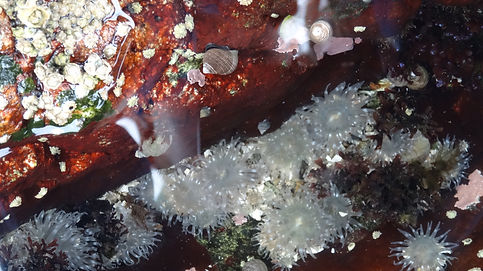
Photo by: Casey Carlson
Schooner Head
BY: CASEY CARLSON and WYLIE WICKS

Image 1: The view from inside of Anemone Cave on Mount Desert Island, Maine is one of its major appeals to visitors (Casey Carlson, 2016)

Image 2: Many visitors to Anemone Cave on Mount Desert Island, Maine feel compelled to capture its peculiar beauty in photographs (Casey Carlson, 2016)
INTRODUCTION
On the western edge of small, coastal Mount Desert Island, Maine is Anemone Cave (see Image 4). Located alongside Acadia National Park, this cave has garnered a reputation as one of the island’s most biologically unique and aesthetically beautiful areas. In fact, the cave itself was included within the span of Acadia National Park in the past - it has only recently been discluded from the Park and subsequently unmarked on maps so as to help reduce human traffic and to better preserve the life it contains. The cave is a hotspot for intertidal pools, within which varying types of algae, barnacles, and, of course, anemones are housed.

Image 4: A grouping of anemones as observed in Anemone
Cave on Mount Desert Island, Maine (Leta Diethelm,
2016)

Image 3:
Anemone Cave is located alongside the eastern coast of Mount Desert Island, Maine (Map Data: Google, 2016).
GEOLOGIC MAKEUP
Immediately noticeable upon entering the cave are the many repeated horizontal and vertical surfaces and fractures in the rock, depicted in Image 5 (see the bottom of the site for raw data of the orientations of these features). The edges created by these intersecting cuts of rock give the cave a very rough and jagged appearance. Upon closer inspection, the rock making up the cave is mostly a dark grey, featuring mild and intermittent rusting on its surface and veins of white quartz (see Image 6). It is very smooth to the touch, and no large crystals are noticeable in the rock - it is essentially a hardened, grey matrix. It is probable that Anemone Cave is made up of a rock known as gabbro-diorite.

Image 5: Anemone Cave on Mount Desert Island, Maine is filled with repeated horizontal and vertical planes of cleavage and fractures its rock faces. Human for scale (Casey Carlson, 2016)

Image 6: The rock making up Anemone Cave on Mount Desert Island, Maine is filled with veins of quartz (Casey Carlson, 2016)
GEOLOGIC HISTORY
The rock making up Anemone Cave, known as the Bar Harbor Formation, is estimated to have been formed about 465 million years ago, when sedimentary rock that was formed in an ancient ocean was intruded by pockets of hot magma. This intrusion essentially “baked” the rock and metamorphosed it into its current metasedimentary form.
Many of the surfaces and fractures in the rock are oriented in the same general direction as many other features and fractures found throughout the entirety of Mount Desert Island. This is because, after the rocks making up the site and surrounding landscape were formed, the shifting of the tectonic plates underlying the area caused stress on and, eventually, fractured the rocks lying above them (Nelson, 2015). This means that not only were the rocks in Anemone Cave split, but rocks across the entire island were split in the same direction! Fittingly, fractures following the same general direction as the ones seen within the cave were found outside of the mouth of the cave (see Image 7).
The existence of the many fractures within the rock of the Maine coast cannot fully explain the existence of Anemone Cave, however: Similarly important to the cave’s formation is the consideration of the cave’s position along the coast of the Atlantic Ocean. Located in an intertidal zone, the cave experiences the continual force of waves rolling in on a relatively large span of elevation. It must be considered that this force has been continuous for millions of years - however long the rock of the cave has been situated along the Atlantic Coast. Additionally, the cross-cutting fractures apparent in the rock act as points of weakness and cleavage (National Park Service, n.d.). Over the long period of time that the rock making up Anemone Cave has been exposed to the rising and falling of continuous Atlantic Ocean wave action, this force has helped wear away at the rock and create the cave as we know it.
More exact details on why the rocks eroded in the specific way they did so as to form a seaside cave is up to speculation. By one estimate, the geologic nature of the area is a result of wall-rock collapsing into a magma chamber during an eruption of an ancient supervolcano (Braun, 2016). We do know that nowadays, the rising and falling of these waters provide intertidal homes for the unique sorts of life that have attracted many visitors over the years. For that, we are thankful; and about that, we are certain.

Data
References
Braun, D., Braun, R., 2016, Guide to the Geology of Mount Desert Island and Acadia National Park: https://books.google.com/books?
id=0vBADAAAQBAJ&pg=PA17&lpg=PA17&dq=geology+of+schooner+head+overlook&source=bl&ots=u7t_dv0dF8&sig=vnWOpwuEYAd3_uAVy9i6jU4NTi4&hl=en&sa=X&ved=0ahUKEwjarLrI-6PQAhVM_4MKHa8hAwgQ6AEIWjAN#v=onepage&q=geology%20of%20schooner%20head%20overlook&f=true
(accessed November 2016).
National Park Service, n.d., Written in Acadia’s Rocks: https://www.nps.gov/articles/Written-in-Acadias-Rocks.htm (accessed November 2016).
Nelson, S.A., 2015, Deformation of Rock: http://www.tulane.edu/~sanelson/eens1110/deform.htm (accessed November 2016).
The Quartz Page, 2011, Occurrence: http://www.quartzpage.de/gen_occ.html (accessed November 2016).
Image 7: Sets of fractures which are consistently parallel not only within themselves, but with the fractures observed within Anemone Cave on Mount Desert Island, Maine are present approximately 30 ft from the mouth of the cave. Field book for scale (Casey Carlson, 2016)

Table 1. Orientations of fractures as found on the ceiling and floor of Anemone Cave, Bar Harbor, ME, as well as of fractures found 30 ft from the cave entrance.
